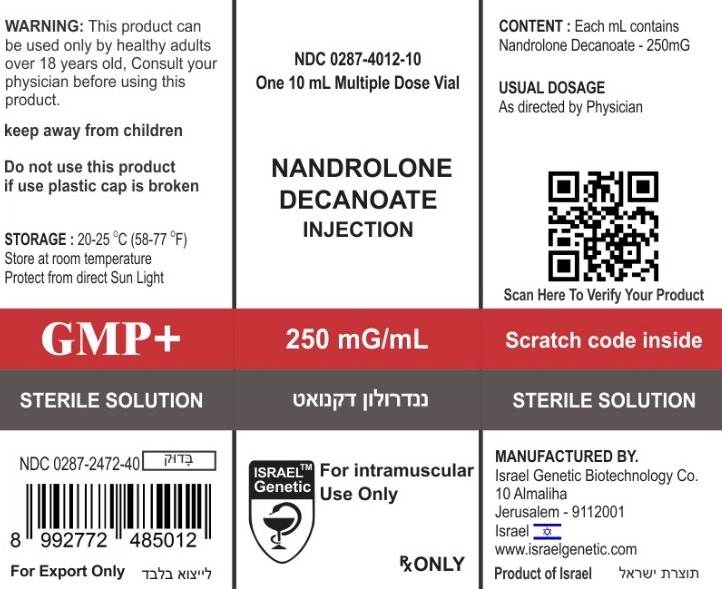
Nandrolone decanoate is clear, pale yellow, oily liquid for Intramuscular administration. Each ml contains 250 mg of Nandrolone Decanoate.
250mg/ ml, 10ml
Nandrolone Decanoate is slowly released from the injection site into the blood stream with a half-life of 6 days. The ester is rapidly hydrolyzed to nandrolone in the blood with a half-life of one hour or less. The half-life for the combined process of nandrolone decanoate hydrolysis , distribution and elimination is 4.3 hours. Nandrolone is metabolized by the liver.
Osteoporosis, catabolic states, renal insufficiency to counteract glucocorticoid, suboptimal growth in children, hypoplastic, hemolytic or malignancy associated anaemia, to enhance physical ability in athletes, chronic debilitating diseases especially in elderly patients to correct defective protein metabolism.
Nandrolone Decanoate is intramuscular injection only, preferably into the gluteal muscle. Dosage should be based on the therapeutic response and consideration of benefit-risk ratio. Duration of therapy will depend on the response of the condition and the appearance of adverse reactions. If possible, therapy should be intermittent. Nandrolone Decanoate should be regarded as adjunctive therapy and adequate quantities of nutrients should be consumed in order to obtain maximal therapeutic effects. For example, when it is used in the treatment of refractory anaemia, adequate iron intake is required for a maximal response. A dose of 50 to 100 mg per week is recommended for women and 100 to 250 mg per week for men. Drug therapy should be discontinued if no hematologic improvement occurred within the first six months.
Hypercalcemia may develop spontaneously as a result of androgen therapy in women with disseminated breast carcinoma. If it developed while on this agent, the usage of the drug should be discontinued.
Caution is required in administering these agents to patients with cardiac, renal or hepatic diseases.
– Male patients with carcinoma of the breast or with known or suspected prostate tumor.
– Brest carcinoma in females with hypercalcemia: androgenic anabolic steroids may stimulate osteolytic resorption of bones.
– Pregnancy, because of masculinization of the fetus.
– Nephrosis or the nephrotic phase of nephritis
Cholestatic jaundice is associated with therapeutic use of the anabolic and the androgenic steroids. Edema may occur occasionally with or without congestive heart failure. Concomitant administration of corticosteroids, ACTH may add to the edema. In children, anabolic steroid treatment may accelerate bone maturation without producing compensatory gain in linear growth. This adverse effect may result in compromised adult stature. The younger the child is, the greater the risk of compromising final mature height might be. The effect on bone maturation should be monitored by assessing bone age of the wrist and hand every six months.
Anabolic steroids may increase sensitivity to oral anticoagulants. Dosage of the anticoagulant may have to be adjusted in order to maintain the prothrombin time at the desired therapeutic level. Patients receiving oral anticoagulant therapy require close monitoring, especially when starting or stopping taking anabolic steroids.
Hepatic Hepatocellular neoplasms have been reported in association with long-term androgenic anabolic steroid therapy.
Genitourinary system:
In men
Prepubertal: Phallic enlargement and increased frequency of erections.
Postpubertal: Inhibition of testicular function, testicular atrophy and oligospermia, impotence, chronic priapism, epididymitis and bladder irritation.
In women:
Clitoral enlargement, menstrual irregularities.
In both genders: Increased or decreased libido.
CNS: Habituation, excitation, insomnia, depression.
Gastrointestinal: Nausea, vomiting, diarrhea.
Hematologic: Bleeding in patients on concomitant anticoagulant therapy
Breast: Gynecomastia.
Larynx: Deepening of the voice in women.
Hair: Hirsutism and male pattern of baldness in women.
Skin: Acne (especially in women and prepubertal boys.)
Fluid and Electrolytes: Edema, retention of serum electrolytes (sodium, chloride, potassium, phosphate, calcium). Metabolic/Endocrine: Decreased glucose tolerance, increased serum levels of low-density lipoprotein and decreased levels of high-density lipoprotein, increased creatine and creatinine excretion, increased serum levels of creatinine phosphokinase (CPK). Some virilizing changes in women are irreversible even after prompt discontinuance of therapy and are not prevented by concomitant use of estrogens.
There have been no reports of acute overdosing with this substance. Symptomatic treatment should be provided
Store in a dark, dry place. Keep away from children.
1x10ml glass vial
Copyright © ISRAEL GENETIC 2020 | All Rights Reserved